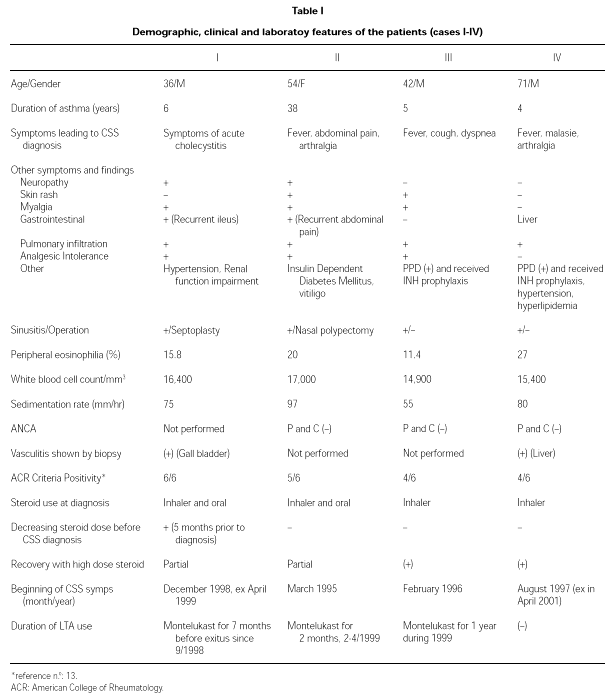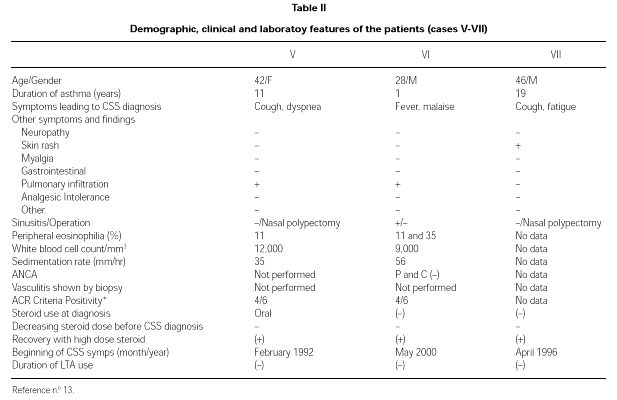INTRODUCTION
Churg-Strauss syndrome (CSS) is a rare, idiopathic, eosinophilic vasculitis appearing in concurrence with asthma which is often severe (1, 2). Some authors have suggested the possible role of antileukotriene drugs on the transformation from asthma to CSS (3-9). Here we report 7 cases of CSS diagnosed in the last 10 years in our clinic where three of them had aspirin-induced asthma (AIA) and in one of them there seems to be a relation to usage of one of the leukotriene antagonists (LTA) montelukast (tables I and II).
Case I
A 36-year-old male was diagnosed as AIA in February 1994 and he had been followed up since then as steroid dependent severe asthma. The dose of 10 mg daily prednisolone had been increased during acute attacks. He had had pansinusitis which had been confirmed by computerized tomography in August 1995. His steroid dose had been decreased to 10 mg every other day when osteoporosis had been diagnosed in April 1998 and he had started receiving montelukast in September 1998. He was hospitalized in November 1998 due to rib fracture as the result of chronic cough and the chest X-ray showed a left paracardiac patchy infiltration and the computed tomography of the thorax disclosed consolidation in the lingula and a minimal infiltration of ground glass appearence in the left upper lobe superior segment. The patient has been discharged upon his will when his pain had relieved to be evaluated again during the control visit one month later and there was no abnormality in his laboratory tests including peripheral eosinophilia. He had undergone a cholecystectomy in another hospital in December 1998 with the diagnosis of acute cholecystitis and the pathologic examination of the operation specimen showed findings compatible with eosinophilic cholecystitis. When fever had appeared in addition to the pain and numbness on his calves the patient had been hospitalized in the hospital where he had been operated in March 1999 after polyneuropathy was detected by EMG and leukocytosis and eosinophilia by laboratory testing. The patient had been transferred to the intensive care unit and his steroid dose was increased to 75 mg/daily when his general condition deteriorated with increasing dyspnea, hypotension and renal function impairment. His chest X-rays had been normal. He had had two attacks of ileus which had recovered spontaneously each time. On the 19th day of his hospitalization the patient has expired due to cardiopulmonary arrest after a sudden left chest pain, hypotension and shock. He had used montelukast for 7 months. He was diagnosed with eosinophylic cholecystitis on his third month of montelukast treatment, while steroid dose had been tapered to 10 mg every other day.
Case II
A 54-year old female has been diagnosed with asthma 38 years ago and she was steroid dependent from the beginning. She had aspirin intolerance for 37 years. Since the beginning of 1995 she has been hospitalized for four times in our hospital due to recurrent pneumonia. She has been having recurrent fever, arthralgia, abdominal pain and skin rash for the last 5 years. She has been hospitalized to investigate the etiology of fever for two times. She has diabetes mellitus, myopathy and osteoporosis which were attributed to oral steroid. During her last hospitalization in February 2000 due to fever, arthralgia and abdominal pain there was eosinophilia in the peripheric blood smear and bilateral patchy infiltration in the computed tomography of thorax. She recovered after increasing her steroid dose from 10 mg every other day to 30 mg/daily. She had used montelukast for 2 months in 1999 which was 4 years after the beginning of recurrent fever, arthralgia, abdominal pain and recurrent pneumonia. This patient has been diagnosed as CSS in 2000 but her symptoms compatible with CSS date back to 1995.
Case III
A 42-year-old male had aspirin intolerance and pansinusitis since 1994. He was admitted with complaints of fever, cough, wheezing and dyspnea in February 1996. Chest X-ray showed bilateral patchy infiltration. He was diagnosed of atypical pneumonia. His symptoms of cough, dyspnea and wheezing did not improve with antibiotic therapy and his pulmonary function test was consistent with asthma in the control examination. His Chest X-ray showed bilateral, wandering pathological infiltration. Inhaled steroid was prescribed with the diagnosis of asthma. Since his symptoms were still not controlled in the second control examination oral steroid was added to the treatment. Although his symptoms subsided with oral steroid recurred after stopping it in July 1996. Further examination demonstrated increasing infiltration in the right upper lobe, leukocytosis, high sedimentation rate and eosinophilia. He has been diagnosed CSS and suggested to continue taking oral steroid. His symptoms are still under control with 20 mg/daily steroid. The patient has used montelukast in 1999 for a year and stopped it as there was no additional improvement in his symptoms. He has been diagnosed of depression in January 2000 and has been using antidepression therapy since then.
Case IV
A 71-year-old male had been diagnosed bronchial asthma 2 years prior to appearance of symptoms of fever, malasie, night fever and arthralgia in August 1997. The laboratory tests had disclosed leukocytosis, eosinophilia, high sedimentation rate, benign monoclonal gammapathy, lingular infiltration in chest X-ray and multiple areas of inflammation or infiltration in the liver in computed tomography of the abdomen. The liver biopsy result had showed a necrotizing granulomatous inflammation with eosinophilia. His symptoms has subsided with oral steroid and has been under control with a dose of 20 mg every other day steroid. He has had no history of leukotriene antagonist drug usage. His monoclonal gammagraphy turned into multiple myeloma in July 2000 and he has died in April 2001 due to thrombocytopenic bleeding.
Case V
A 42-year-old female has been diagnosed bronchial asthma in April 1989 and she has been steroid dependent since December 1991. She had eosinophilia of 11 % in peripheral smear of blood which was performed for another purpose in February 1989. She had history of nasal polypectomy (November 1991). She had bilateral irregular opacities in her chest X-ray which was performed in February 1992 when she referred to our out-patient clinic with complaints of cough, sputum and dyspnea. The pulmonary angiography revealed findings consistent with pulmonary vasculitis. The computed tomography of the thorax revealed thickenning in the bronchial walls bilaterally where the opacities in the chest X-ray had disappeared without any treatment. She has had osteoporosis and is still receiving tratment for it. Her disease is under control with 20 mg/daily prednisolone.
Case VI
A 28-year-old male has been diagnosed bronchial asthma in November 1999. He has referred with fever and malaise in May 2000 when a sedimentation rate of 56 mm/hr and a eosinophilia of first 11 % and a month later 35 % was determined. Computed tomography of the paranasal sinuses revealed pansinusitis in July 2000. His skin prick test with common aeroallergens were negative. The computed tomography of thorax showed an infiltration starting from the right apex descending to the lower lobe superior segment mainly located in the periphery of the lung. The fiberoptic bronchoscopy performed in June 2000 was normal except the transbronchial lung biopsy specimen which showed eosinophils in the alveoli and the walls of the alveoli. The high resolution computed tomography of the thorax performed in October 2000 revealed patchy infiltration of mixed acinery and microdular pattern located in the superior segments of the lower lobes of the both lungs. He has been treated with 20 mg/day of prednisolone for 20 days and then with tapered dose for two and a half months. The pANCA an cANCA tests were negative. His disease is in remission with 800 μg/daily inhaled budesonide.
Case VII
A 46-year-old Turkish male living in Germany during the winter had referred with dry cough and fatigue with a duration of about one and a half months in June 1996 to a university hospital in Munich. He had had recurrent cough since 1981. He had been hospitalized for five weeks and diagnosed CSS. He had been suggested to receive a treatment of oral prednisolone of 20 mg daily which had been tapered and stopped over a duration of six months. He had recovered and received 800 μg/day budesonide for a year. Since then he has been using inhaled steroid on a as needed basis about 3 months a year. He has been performed nasal polypectomy four years ago. His mother has asthma and brother has aspirin-induced asthma. Since he lives in Turkey for 6 months of the year he has also followed up in our clinic. He is now in remission.
DISCUSSION
In the case reports of CSS in the literature asthma is classically reported in a rate of up to 100 % and 1/3 of these are severe, steroid dependent (1). The triggering factors precipitating CSS syndrome in these patients were reported as desensitization, rapid discontinuation of oral corticosteroid, vaccination, lumbar infiltrations of novocaine, exposure to fresh-cut hay, intravenous human placental immunoglobuline administration and ingestion of tryptophan (1, 2). Although oral antileukotriene drugs are blamed for this condition, their role is not very clear. There are several reports which mentioned the association between zafirlukast-montelukast and CSS and/or CSS-like syndrome appearing with pulmonary infiltrates and eosinophilia (3, 4). However some other reports did not suggest any association (8, 9).
AIA is a special clinical syndrome appearing in about 10 % of the adult asthmatics (10, 11). In a recent survey CSS was diagnosed in 23 out of 440 patients with AIA (12). Similar to this 3 of our 7 CSS patients had AIA. Fifty four thousand fifteen patients has been admitted to our out patient clinic during the last 10 years (1991-2000). Four hundred ninty eight of these were diagnosed analgesic intolerance with/without asthma and among these 250 had AIA. The prevalence of CSS among all the admitted patients were 0.013 %, among the analgesic intolerant patients 0.60 % and among the aspirin-induced asthmatic ones it was 1.2 %. These data should be interpreted with caution as they are derived from a university clinic which are third step health institutions in Turkey.
It is obvious that in cases II and III there is no association between CSS and LTA drug as symptoms of CSS started long before the use of these drugs. In cases IV-VII there is no LTA drugs usage. The first case was diagnosed CSS by cholecystectomy after 3 months of using montelukast, but his systemic steroid dose was decreased due to osteoporosis, which had ended up with spontaneous rib fracture, 5 months prior to beginning montelukast therapy; so there is also no clear relation between CSS in this patient and LTA drugs. The second case was diagnosed as CSS in 2000 by retrospective reevaluation of her symptoms starting in 1995. This might be due to our increased awareness about CSS after LTA drugs are marketed in our country.
Since AIA patients have also moderate-severe asthma, the asthmatics with AIA warrants special attention about possible transformation into or accompaniment to CSS. Possible explanations for AIA and CSS association include decreasing the steroid dose due to antileukotriene drugs and the possible role of drugs themselves or the natural course of the disease itself. The issue is important and warrants further investigation. These cases should be collected to be reevaluated by a meta-analysis in the future. It is critical that this syndrome which might be fatal can be prevented by just being cautions with the severe and late onset asthmatics with the features of a multisystem disease especially if they have aspirin or analgesic intolerance.








